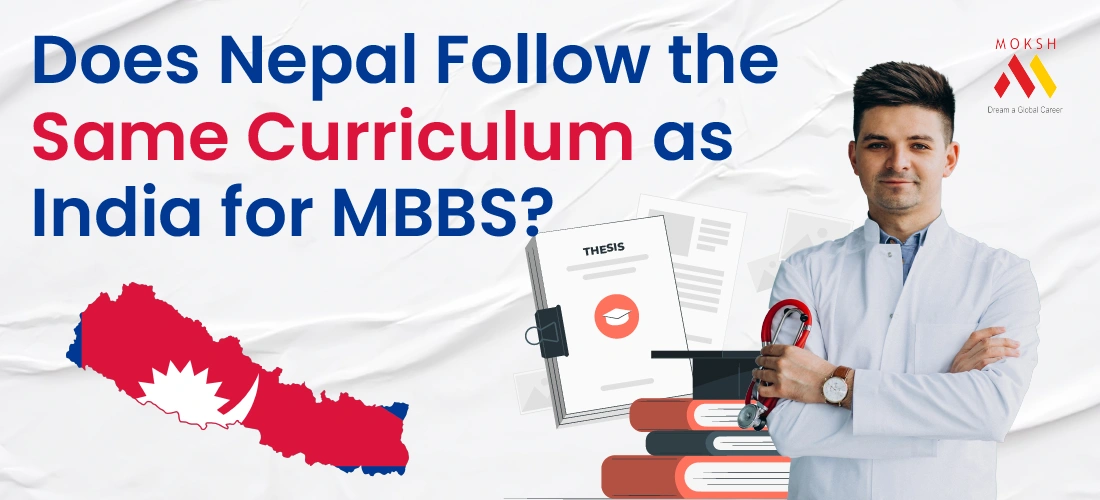
For Indian students aiming for a career in medicine, both Nepal and India offer promising MBBS (Bachelor of Medicine, Bachelor of Surgery) programs. However, with the ever-increasing competition for medical seats in India, many students are exploring options abroad. A common question that arises is: Does Nepal follow the same curriculum as India for MBBS?
The answer isn't a simple yes or no. While there are significant similarities, there are also key differences to consider. This blog delves deep into the curriculum comparison between MBBS in Nepal and India, helping you make an informed decision about your medical education journey.
Similarities in the MBBS Curriculum:
Structure and Duration:
Nepal and India follow a similar MBBS program structure, typically lasting for four and a half academic years and a one-year internship.
Core Subjects:
The core subjects covered in the MBBS curriculum are essentially the same in both countries.
These include:
- Anatomy
- Physiology
- Biochemistry
- Pathology
- Microbiology
- Pharmacology
- Community Medicine
- Medicine
- Surgery
- Obstetrics and Gynecology
- Paediatrics
Focus on Practical Training:
Both Nepal and India emphasize practical training alongside theoretical knowledge. This includes dissections in anatomy labs, clinical rotations in hospitals, and hands-on experience with patients.
Recognition of Degrees:
MBBS degrees obtained from universities recognised by the MCI or its successor, the National Medical Commission (NMC), are valid for practising medicine in India after clearing the qualifying exam (currently, the Foreign Medical Graduates Examination, or FMGE). Many Nepalese medical universities are NMC-approved, making them a viable option for Indian students.
Key Differences in the Curriculum:
Language of Instruction:
The most common language of instruction in most Indian medical colleges is English. However, in Nepal, the language of instruction can vary depending on the university. Some universities offer English-medium programs, while others use Nepali. This can be a deciding factor for Indian students who may prefer a program entirely in English.
Pedagogical Approaches:
While both countries emphasize practical training, the specific teaching methods may differ. Some Nepalese universities might adopt a more modern, technology-integrated approach compared to traditional Indian techniques.
Elective Courses:
The availability and range of elective courses offered might vary between Nepalese and Indian universities. Your specific area of interest within the medical field might influence your decision.
Here's a summarising the key points:
Factors to Consider Beyond Curriculum:
Cost of Education: MBBS programs in Nepal are comparably affordable to private medical colleges in India. This can be a significant benefit for budget-conscious students.
Living Expenses: The cost of living in Nepal is typically lower than in major Indian cities. This can further add to the overall financial feasibility of studying MBBS in Nepal.
Admission Process: The admission process for MBBS programs can differ slightly between the two countries. Nepalese universities might have their own entrance exams or selection criteria in addition to NEET scores, while Indian universities primarily rely on NEET scores for admissions.
Cultural Similarities: Nepal and India share a rich cultural heritage, which makes the transition for Indian students to life in Nepal smoother.
Is the MBBS curriculum in Nepal similar to India?
Nepal, with its proximity to India and growing medical infrastructure, has become a preferred destination for Indian students seeking quality medical education. The Medical Council of India recognises specific medical colleges in Nepal, allowing Indian students to pursue MBBS courses there. However, it's essential to understand that while some colleges in Nepal follow a curriculum similar to India, there are variations in certain aspects.
Many medical colleges in Nepal are affiliated with universities like Tribhuvan University, Kathmandu University, and B.P. Koirala Institute of Health Sciences. These institutions offer MBBS programs that align closely with the curriculum outlined by the respective university and the Nepal Medical Council (NMC). The syllabus covers subjects comparable to those in India, including Anatomy, Physiology, Biochemistry, Pathology, Pharmacology, Microbiology, and Clinical Medicine.
However, despite the similarities in subject matter, there are differences in the duration of the MBBS program and the structure of the curriculum. In Nepal, the MBBS course typically spans five and a half years, similar to India, but the internship duration may vary. While Indian medical students undergo a one-year compulsory rotatory internship, Nepali MBBS graduates may have internship periods ranging from one to two years, depending on the institution.
Furthermore, the medical education and clinical training approach may vary slightly between India and Nepal. Factors such as healthcare infrastructure, patient demographics, and clinical practices influence the training methodologies adopted by medical colleges in both countries. Therefore, while the core curriculum remains consistent in many aspects, students may encounter variations in teaching methodologies and clinical exposure.
Making an Informed Decision:
If you're an Indian student considering an MBBS degree in Nepal, carefully research the curriculum offered by specific universities. Explore factors beyond the curriculum, including:
- Accreditation status of the university (NMC recognition)
- Availability of English-medium instruction
- Faculty qualifications and teaching methods
- Infrastructure and facilities
- Hostel and accommodation options
- Overall student experience and reviews
Conclusion
While the MBBS curriculum in Nepal and India shares many similarities, there are key differences to consider. By connecting with a study abroad consultant, you will get the right pathway without any research. Indian students can make a well-educated decision about pursuing their MBBS dream in Nepal. Remember, the most important aspect is choosing a program with a strong reputation, quality education, and NMC recognition, paving the way for a successful medical career in India.






.webp)
